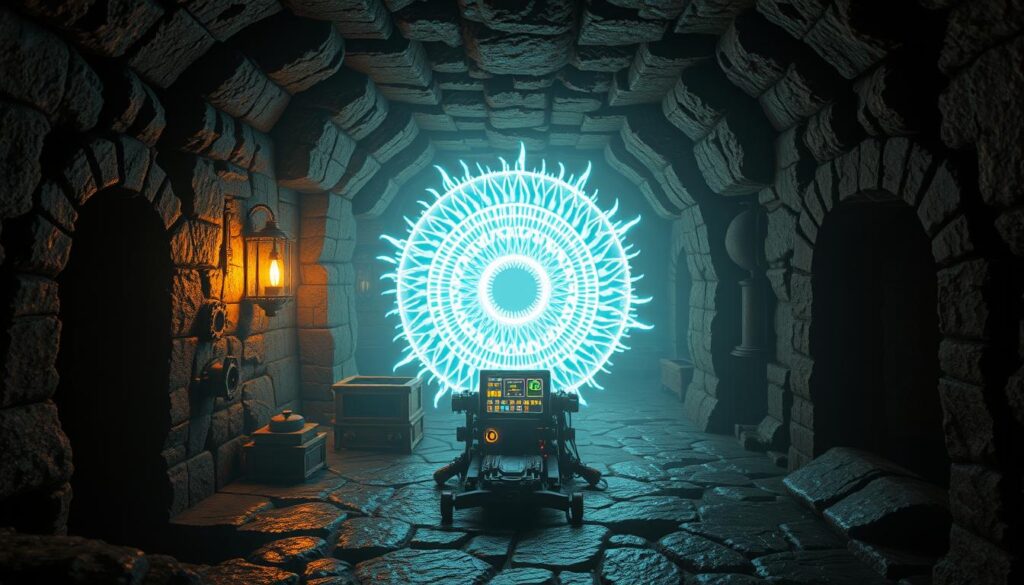Ever wondered how survival games keep you hooked while exploring new dungeons? The key is in monitoring procedural dungeon loading. Players want smooth transitions and exciting experiences. Knowing how to improve loading is key for game makers.
This section talks about why watching dungeon loading is important. It helps keep players interested and fully into their games.
The Importance of Procedural Generation in Survival Games
Procedural generation is key in making survival games exciting. It lets developers create dynamic worlds. These worlds are vast and varied, changing based on player choices.
Games like Minecraft and No Man’s Sky show its power. They make the game world feel real and engaging.
Using procedural generation saves time and resources. It lets developers work on making the game better, not just designing everything. This way, players always find something new to explore.
Procedural generation makes each game unique. Players face different challenges every time they play. This keeps the game exciting and fresh.
It turns survival games into ongoing adventures. It’s not just a choice for developers; it’s what makes survival games special. It changes how players see and interact with the game world.

Understanding Dungeon Loading Mechanics
In procedural survival games, the way dungeons load is key to the player’s experience. These mechanics control how levels and environments are loaded and shown. This greatly affects how smooth the game feels.
Good loading systems make sure players can move easily through the game’s world. This is especially true in games with changing dungeons. It keeps the game feeling natural and engaging.
Games use streaming assets to handle the game’s physics well. This means players can interact with the game in real-time without any delays. When players enter new areas, the game loads quickly, keeping them fully immersed.
Knowing how loading systems work is important for keeping the game running smoothly. It also helps create an exciting atmosphere that makes players want to explore more. By using the right programming and managing assets well, games can create worlds that feel real and interactive.

Exploring the Role of Streaming Techniques
Streaming techniques are key in modern game design, especially in survival games. They make sure the game runs smoothly without long loading times. This is done through methods like level of detail (LOD) management, which keeps the game looking great without pauses.
Good asset management is vital for a game’s performance. It lets players move easily between different game worlds. This makes the game more fun and keeps players in the action, without the usual loading screen breaks.
Asynchronous loading is a big plus of streaming techniques. It lets assets load in the background while players keep playing. This way, developers can create big, detailed worlds that players can explore without any hitches.
| Streaming Technique | Description | Benefits |
|---|---|---|
| Level of Detail (LOD) Management | Adjusts the quality of assets based on the player’s distance from them. | Reduces performance costs, enhances detail in close proximity. |
| Asynchronous Loading | Loads assets in the background without interrupting gameplay. | Maintains immersion, reduces loading screens. |
| Dynamic Asset Streaming | Streams assets based on player location and activity. | Optimizes memory use, improves world density. |
Monitoring Dungeon Loading in Procedural Maps
Dynamic physics make procedural maps more engaging. Players feel like they’re really there because of how objects react. By watching loading times closely, developers can make sure everything runs smoothly.
How Dynamic Physics Affect Dungeon Interaction
Dynamic physics change how players interact with the game. It makes every action feel special. Testing these interactions helps improve the game’s loading times.
A game with good physics is more fun. Players want their actions to have real effects.
Optimizing Dungeon Loading for Immersion
To keep players hooked, loading times need to be short. Preloading and improving collision detection help a lot. Asynchronous loading also makes the game feel smoother.
Developers must find the right balance. They need to keep the game running smoothly without slowing it down.
Common Challenges in Monitoring Dungeon Loading
Watching how dungeons load in survival games can be tough. It affects how players enjoy the game. To fix this, we need to know what slows things down and how to speed them up. Finding and fixing these delays is key to better gameplay and keeping players interested.
Addressing Loading Time Delays
Managing delays in loading is a big challenge. These delays can come from bad asset management, slow networks, or too much work for computers. Knowing what causes these delays is the first step. Here are some common reasons:
- Poorly optimized game assets
- High-resolution textures or models
- Insufficient server speed or bandwidth
- Complex procedural generation algorithms
By keeping an eye on these issues, developers can fix them quickly. This makes the game better for everyone.
Mitigating Player Frustration during Load Screens
Long load screens can really upset players. They make the game less fun. To make waiting better, developers can try a few things:
- Implementing engaging animations or visuals
- Providing background music or sound effects
- Offering gameplay tips or lore snippets
Using these ideas, developers can make waiting more enjoyable. This keeps players interested, even when they have to wait.
Tools and Techniques for Effective Monitoring
Monitoring procedural dungeon loading needs special tools. These tools help improve performance metrics. They let developers check how well maps load and find slow spots.
By looking at asset load times and memory use, they can spot areas to make better. This makes the game run smoother for everyone.
Utilizing Performance Metrics
Performance metrics are key to knowing if loading is efficient. Developers track how assets perform. This shows how long it takes to load on different devices.
Tools for load monitoring help make games run better. By always checking this data, creators keep games running great. This makes players happier and more engaged.
Leveraging Analytics for In-Depth Insights
Analytics tools give deep insights into how players act and how loading works. Developers learn a lot from this. They can make the game better by understanding player behavior and loading times.
By adjusting loading times based on what analytics show, developers can make the game more fun. This makes the game feel more real and exciting.
Best Practices for Implementing Procedural Loading
Procedural loading works best when you follow the best practices. These practices make the game more enjoyable and keep the gameplay smooth. It’s important to have good transition strategies to move between levels smoothly.
By using techniques like synchronized loading zones and preloading assets, you can reduce interruptions. This creates a more engaging game atmosphere.
Creating Seamless Transitions Between Levels
Creating smooth transitions between levels is key. It keeps players engaged in the game world. Good transition strategies include:
- Using synchronized loading zones to get assets ready before the player arrives.
- Adding visual cues like ambient changes or animations to keep players interested during load times.
- Keeping gameplay mechanics going during transitions to improve the player’s experience.
Synchronizing Game Assets for Smooth Gameplay
Syncing game assets is crucial for better performance and smooth gameplay. Here are some practices to follow:
- Manage asset states during transitions to load needed items early.
- Use background threads to speed up the loading process without stopping the player.
- Apply efficient memory management to cut down on loading times and boost performance.
Enhancing Survival Game Experience through Optimization
Game optimization is key to a better player experience in survival games. Getting feedback on loading times helps developers a lot. They can make changes to meet player expectations and boost satisfaction.
By listening to players, developers can make the game more immersive. This makes the gaming experience better for everyone.
Player Feedback and Adjusting Load Times
Talking to players regularly gives developers important feedback. They can use this to improve the game. This way, they can make the game faster and more enjoyable.
Creating a feedback loop helps keep the conversation going. It lets developers respond fast to player concerns. This builds trust and a sense of community among players.
Using Community Insights for Continuous Improvement
Getting involved with the community is crucial for survival game development. Tracking their suggestions helps developers improve the game. They can fix issues that might bother players.
This teamwork not only makes the game better but also keeps players happy. It creates a loyal fan base ready to help improve the game.
The Future of Procedural Dungeon Design
The world of dungeon design is changing fast thanks to new tech. Soon, we’ll see more advanced procedural generation using AI. This will lead to unique, complex environments for every player.
Game makers want to add deeper stories to dungeons. Now, they can use algorithms to make environments that change based on player choices. This could make each dungeon feel like a special part of a big story.
Machine learning will also help make games more personal. It can adjust challenges and layouts based on how players play. This could make games more fun and improve them over time based on what players like.
| Aspect | Current State | Future Trends |
|---|---|---|
| Complexity | Standard algorithms | AI-enhanced complexity |
| Interactivity | Limited player interaction | Dynamic player-driven environments |
| Narrative Integration | Surface-level storytelling | Deep narrative immersion |
| Environment Diversity | Similar layouts across games | Unique experiences per playthrough |
These changes in procedural dungeon design will make games better and more engaging. As tech keeps getting better, so will the possibilities for new dungeons. Designers will likely create even more exciting and meaningful experiences for players.
Case Studies on Successful Dungeon Monitoring
Looking at case studies of successful dungeon monitoring gives us key insights. Different games have used new ways to make the game better. These examples can help other developers improve their games.
Don’t Starve Together is a great example. It uses procedural generation to keep players interested. The game tracks data on how fast it loads and how players interact. This helps make the game better for everyone.
Raft is another example. The game worked on making loading faster. This made the game smoother and less interrupted. It shows how important good monitoring is.
| Game Title | Monitoring Approach | Outcome |
|---|---|---|
| Don’t Starve Together | Real-time data collection | Improved player satisfaction |
| Raft | Streamlined loading processes | Smoother gameplay experience |
| Dead Cells | Adaptive procedural generation | Increased player retention |
These examples show how important good monitoring is. They show how adapting and improving these systems can make games better. Developers can learn a lot from these examples to make their games more fun and engaging.
Player Engagement and Procedural Loading
Player engagement is key to a survival game’s success. Good loading strategies make the game feel seamless. This keeps players hooked and invested in the game world.
Using smart loading methods can improve game design. Players won’t get bored or leave during long waits. It’s important to balance loading with player interaction to keep them playing.
A smooth experience keeps players excited for more. By focusing on strategies that keep players engaged, developers can make sure they’re eager to dive into new challenges.
Innovative Approaches to Loading Systems
Game development keeps getting better, thanks to new ways of loading systems. One cool method is spatial partitioning. It loads assets based on how close players are to them. This means only loading what’s needed for the area around the player.
Using these new methods makes games feel smoother. Games load faster, keeping players in the game world. This is key for survival games, where players need to stay focused.
Also, predictive loading algorithms make games more interactive. They guess what players will do next and load the needed assets early. This makes games more enjoyable and less stressful for players.
Potential Drawbacks of Procedural Generation
Procedural generation in survival games brings exciting possibilities for dynamic environments. However, it also has some drawbacks that can affect gameplay quality. The unpredictability in level design can lead to inconsistent player experiences.
While players enjoy the surprises, they might also face poorly designed layouts. These can hinder their progress and make the game less enjoyable.
Creating robust algorithms is another technical challenge developers face. They need to make sure the environments are not repetitive. If not, players might find themselves in the same landscapes over and over again.
This can take away from the excitement that procedural generation aims to bring. Balancing randomness with structured design is a constant challenge for game developers. They must keep working on their algorithms to avoid these drawbacks and create immersive gaming experiences.
Comparative Analysis of Procedural vs. Static Loading
Procedural loading and static loading have their own benefits and drawbacks. They affect how games perform and how players feel. Procedural loading makes environments change as you play, offering new and exciting experiences. It uses less memory because only what’s needed loads as you go.
Static loading, however, is steady and reliable. Developers can make static assets look and work better. Players get the same experience every time they visit a place. But, it might not be as creative because it uses pre-made content.
Here’s a table showing the main points of each loading method:
| Feature | Procedural Loading | Static Loading |
|---|---|---|
| Asset Variety | Diverse and dynamic environments | Limited to pre-designed assets |
| Memory Usage | Efficient; loads assets as needed | Potentially higher due to all assets being pre-loaded |
| Player Experience | Unpredictable, enhancing replayability | Consistent but may feel repetitive |
| Development Complexity | Higher complexity; requires advanced algorithms | More straightforward and predictable |
This comparison shows that picking between procedural and static loading depends on what you want your game to be like. It’s important to think about what each method offers. This way, you can create a game that keeps players interested and involved.
Conclusion
Monitoring procedural dungeon loading is key to a better survival game experience. We’ve seen how good loading techniques boost player engagement and immersion. By mastering dungeon loading and using advanced streaming, developers can make games feel seamless and engaging.
Looking ahead, technology will keep improving, and so will procedural generation methods. Tools and analytics will become even more important in making games better. This will help developers create dynamic, unforgettable worlds for players.
Using smart procedural dungeon loading strategies helps solve current problems and opens up new possibilities. As we look to the future, procedural techniques in game development are exciting for both developers and players.
FAQ
What is the role of procedural generation in survival games?
Procedural generation is key in survival games. It makes vast, diverse environments on the fly. This makes the game more engaging and immersive for players.
How does dungeon loading affect player immersion?
Dungeon loading affects immersion a lot. Quick loading keeps the game flowing smoothly. This keeps players engaged and in the game world.
What are streaming techniques, and how do they help in dungeon loading?
Streaming techniques load game assets continuously. This means no more loading screens. It makes moving between levels smooth and enhances the game experience.
What common challenges do developers face with dungeon loading?
Developers struggle with slow loading times. This is due to bad asset management and high demands on computers. Network problems also cause issues.
How can player feedback improve dungeon loading times?
Player feedback is gold for developers. It shows where loading times are slow. This lets them work on making the game load faster.
What metrics should developers use to assess loading efficiency?
Developers should look at asset load times and memory use. They also need to check how players act. This helps find and fix slow spots.
Why are seamless transitions between levels important?
Smooth transitions keep the game going without pause. This is key for keeping players in the game world.
What are some best practices for procedural loading?
Good practices include synchronized loading and preloading assets. Level of detail (LOD) management also helps. These steps keep the game running smoothly.
How is community engagement valuable in optimizing dungeon loading?
Community feedback is priceless. It gives developers direct insight into what players feel. This lets them tweak the game for better performance.
What emerging trends are shaping the future of procedural dungeon design?
New trends like AI and advanced algorithms are coming. They promise to make game worlds even more detailed and immersive.




